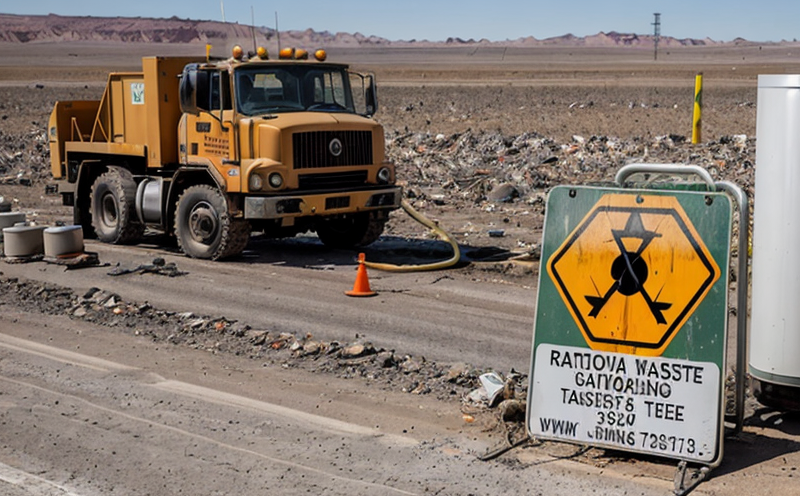ASTM C1009 Determination of Plutonium in Radioactive Waste
The ASTM C1009 standard method provides a precise and reliable procedure for determining plutonium content in radioactive waste. This analytical process is critical for ensuring regulatory compliance, environmental safety, and the safe handling and disposal of nuclear materials. The test focuses on the quantitative analysis of plutonium isotopes within complex matrices such as soil, sludge, and ash.
The methodology involves a series of steps including sample preparation, digestion, separation, purification, and final measurement using instrumental techniques like inductively coupled plasma mass spectrometry (ICP-MS). The accuracy and precision of the results are paramount due to the significant health and environmental risks associated with plutonium exposure.
ASTM C1009 ensures that the measured values meet specified acceptance criteria, which include both detection limits and reporting levels. This standard is essential for laboratories involved in nuclear waste management, regulatory compliance, and research institutions dealing with radioactive materials.
The process begins with thorough sample preparation to ensure homogeneity and representativeness of the waste matrix. Digestion methods such as nitric acid digestion are commonly used. After digestion, the plutonium isotopes are separated from other elements using techniques like coprecipitation or ion exchange chromatography. The purified isotopes are then measured using ICP-MS.
The acceptance criteria for ASTM C1009 include a detection limit of 5 ng/g and reporting levels that depend on the specific application. For instance, in waste disposal applications, lower limits may be required to ensure minimal contamination levels. Reporting is typically done with an associated uncertainty value, which must meet the requirements set by regulatory agencies.
The precision and accuracy of the results are critical for decision-making processes such as waste classification, treatment options, and final disposition methods. Regulatory compliance requires that laboratories performing this test adhere strictly to ASTM C1009. This ensures consistent and comparable data across different testing facilities.
Understanding the complexities involved in sample preparation and digestion is crucial for obtaining reliable results. Proper technique minimizes matrix effects and potential interferences, which can significantly impact the accuracy of the plutonium concentration measurement. The use of high-quality reagents and standard operating procedures (SOPs) further enhances reliability.
The importance of ASTM C1009 in ensuring safe handling and disposal practices cannot be overstated. By providing a standardized approach for determining plutonium concentrations, this method supports the development of effective waste management strategies that protect public health and the environment.
Industry Applications
The ASTM C1009 standard is widely used in various sectors where radioactive waste testing is critical. Quality managers rely on it to ensure compliance with international standards such as ISO 17025 for laboratory accreditation. Compliance officers use this method to verify that nuclear facilities meet regulatory requirements set by organizations like the International Atomic Energy Agency (IAEA) and national regulatory bodies.
R&D engineers benefit from ASTM C1009 when developing new methods for waste treatment and disposal. The standard provides a robust framework for validating experimental protocols, ensuring reproducibility of results across different laboratories. Procurement departments also find it valuable in vetting vendors who provide analytical services for radioactive waste testing.
One key application is in the nuclear fuel cycle where ASTM C1009 helps monitor plutonium content at various stages from fuel fabrication to spent fuel management. Another important use case is in environmental remediation projects, particularly those involving contaminated sites. Here, the method ensures that cleanup efforts are effective and that residual levels of plutonium meet stringent safety thresholds.
The standard also plays a role in supporting decommissioning programs for nuclear facilities. By accurately determining plutonium concentrations, this process aids in planning disposal strategies that minimize risks to workers and the public.
- Nuclear fuel cycle monitoring
- Environmental remediation projects
- Decommissioning of nuclear facilities
- Spent fuel management
The diverse applications of ASTM C1009 underscore its significance in maintaining safety and compliance across the nuclear industry. Its role in supporting critical decision-making processes cannot be overstated.
Environmental and Sustainability Contributions
The determination of plutonium in radioactive waste through ASTM C1009 contributes significantly to environmental protection and sustainability initiatives. By accurately quantifying plutonium levels, this method enables effective management of nuclear waste, reducing the risk of contamination and ensuring safe disposal practices.
One of the primary goals is to minimize long-term environmental impacts associated with radioactive materials. The standard helps in developing strategies that prevent the spread of plutonium into soil, water bodies, or air, thereby protecting ecosystems and human health. This aligns with broader sustainability objectives aimed at reducing nuclear waste footprints and promoting safer disposal methods.
ASTM C1009 also supports efforts to improve public trust by providing transparent data on plutonium concentrations in radioactive waste. This enhances regulatory compliance and ensures that all stakeholders, including the general public, have confidence in the safety measures implemented.
The method contributes to sustainable practices by facilitating informed decision-making regarding nuclear fuel cycle processes. By accurately tracking plutonium levels, this helps optimize resource utilization and minimize waste generation throughout the lifecycle of nuclear materials.
Furthermore, ASTM C1009 supports international cooperation on environmental protection through its alignment with global standards like ISO 14001 for environmental management systems. This fosters a collaborative approach to addressing shared challenges in managing radioactive waste safely and sustainably.





